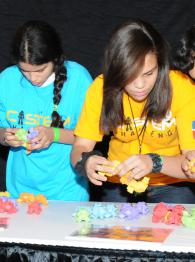
About the Project
This project is one of the 2011 WISE Awards finalists.
For more than a decade, C-STEM has provided teachers and students with hands-on experience in science, technology, engineering, and mathematics (STEM) disciplines through the CSTEM Challenge. The Challenge provides both students and teachers with the opportunity to engage in fun, challenging, creative, and innovative projects that can be implemented at any learning level.
Context and Issue
C-STEM successfully addresses the disparities in underserved communities and underperforming schools, where young people are most in need of STEM education. C-STEM focuses on strengthening both students’ and teachers’ confidence levels with regard to academic achievement in STEM disciplines and student/teacher/parent engagement. It specifically addresses the need to support integrated communication, science, technology, engineering, and mathematics education within Pre-K through 12th-grade traditional learning environments.
STEM represents subjects that overlap and span all sectors of life and living. Education systems require support to help adapt and respond to the paradigm shifts that include online learning, hybrid learning, collaborative models, real-world project-based learning, abundant access to resources via the Internet, and the integration of personal technology tools/gadgets into traditional education environments.
Solution and Impact
C-STEM builds on fundamental best practices in STEM education as well as prior research and development efforts that provide theoretical and empirical justification for student and teacher engagement in C-STEM programs. The project encourages student entry into the talent pipeline, bolsters self-confidence, and fosters a well-rounded mastery of content in a competitive environment demonstrating innovative responses to C-STEM toolkits and curriculum. The experiential learning supports the application of integrated STEM, emphasizing art and engineering. The rigorous and relevant curriculum and competitive environment nurtures critical thinking, creativity, collaboration, and exploration.
The key strengths of the project are:
- online training courses for teachers and students that supplement learning communication, science, technology, engineering, and mathematics disciplines;
- the innovative, relevant, and rigorous STEM curriculum and tool-kits;
- the web-based CSTEM break social network that supports teachers and students in connecting and sharing learning experiences and research, and collaborating globally using technology devices that connect to the Internet
In terms of impact, the project has had the following results:
- increased participation of diverse populations in innovative STEM learning;
- increased STEM resources in the hands of teachers and students that enhance, inform, and/or empower instructional pedagogy;
- the development of Logic Models that provide a framework for the organization, inform action, and identify community engagement activities;
- the design and development of innovative structures and tools that engage students in 21st-century STEM content;
- enriched learning environments that promote increased teacher content knowledge, collaborative partnerships, and expanded networks.
C-STEM’s understanding that underserved and underrepresented groups constitute the largest unempowered majority in STEM workforce areas is what makes these groups the primary beneficiaries of its work in the community. Students and teachers are also direct beneficiaries. Communities, STEM employers, universities/colleges, parents, and school systems are the indirect beneficiaries. To date, more than 60,000 people have benefited from the program.
In the US, the project has been developed in Texas, Maryland, Mississippi, Tennessee and Louisiana. It is also being replicated in the Dominican Republic and in South Africa. The initiative is currently exploring expansion to the UK.
Future Developments
The objective over the next five years is to take current practices to scale with C-STEM’s evidence-based programming. C-STEM’s overarching goal is to advance Pre-K through 12th graders’ knowledge and skills in communication, science, technology, engineering, and mathematics learning through expanded use of resources such as virtual and remote laboratories, advancements with 3D printing, and hands-on learning platforms/environments.
C-STEM has developed a strategic implementation plan that focuses on generating increased opportunities for collaboration, flexible learning environments, and real-world projects. Continuous collection of data and evaluation will guide programming and practices. C-STEM has also leveraged learning modules through technology that students may already own. It is currently utilizing more cloud-based tools and will increase the use of open resources, and offer more online courses that can support C-STEM learning beyond participants in specific projects.


